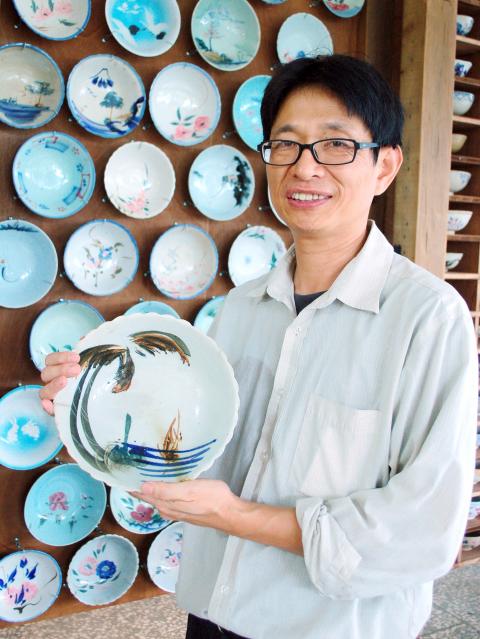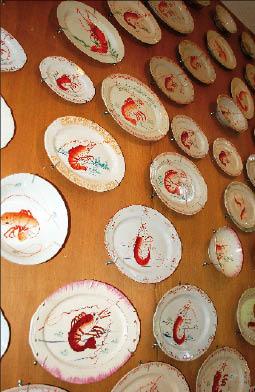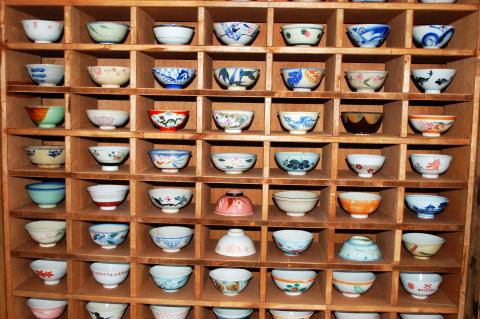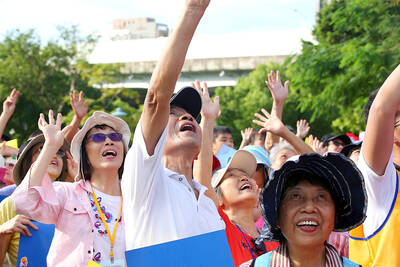The Taiwan Bowl and Dish Museum opened in Yilan County’s Yuanshan Township this past Saturday, housing an art collection of over 20,000 bowls, plates and other eating utensils. Chien Yang-tong, the museum’s founder, says that regardless of whether a person is poor or rich, bowls and plates are still used when a person eats their three daily meals. During the 30 years following World War II, it was popular to paint bowls and plates by hand, which feature a lot of local characteristics, for example, auspicious designs consisting of fish and shrimp, coconuts and the ocean, plum blossoms and orchids, bamboo and chrysanthemums, or even Fukurokuju, the god of happiness, wealth, and longevity in Japanese mythology, all representing the contemporary culture at the time they were made.
Chien says that since the 1970s, plastic eating utensils and machine-made ceramics have become common, causing people to feel a sense of nostalgia for the hand-painted eating utensils of our grandparents’ generation, back when every plate and bowl’s design was slightly different. Although the craftsmanship of ceramics at the time was far from perfect, they still give people a sense of ancient simplicity and refined familiarity, speaking volumes to the arduous enterprise craftsmen undertook to make them.
The museum is located inside Surewell’s headquarters next to Yuanshan’s Leikung Lake. It opens daily from 9am to 5pm. Tickets are NT$120, but there is a 50 percent discount for the first three months they are open, and children less than 120cm tall and disabled people can visit the museum free of admission. For more information visit the museum’s Web site at http://www.facebook.com/Taiwan.Bowl.Dish.Museum.
(Liberty Times, Translated by Kyle Jeffcoat)

Photo: Yang Yi-min, Liberty Times
照片:自由時報記者楊宜敏
蒐集二萬多件碗盤藝術品的台灣碗盤博物館,上週六在宜蘭縣員山鄉開幕,博物館創辦人簡陽同說,吃飯的碗盤,不論是市井小民或家財萬貫的富翁,每天三餐都會使用到,尤其是二次世界大戰後三十年,台灣的手工彩繪碗盤興盛,極具台灣在地特色,像是魚蝦、椰風海景,或是梅蘭竹菊、甚至日本神話中的「福祿壽」等吉祥圖案,都反映當時的社會文化。
他說,七十年代以後,塑膠餐具製品興起、機械生產的陶瓷,更讓人懷念阿公阿嬤時代手繪、每個圖案都不盡相同的碗盤,雖然當時的陶瓷作工較為粗糙,卻給人一種古樸素雅的親切感,更道盡先民篳路藍縷的辛勞。
台灣陶瓷博物館開設在員山鄉雷公埤旁的喜互惠總部內,每天開館時間為上午九時到下午五時,門票原價一百二十元,開幕前三個月五折優待,身心障礙者憑證或一百二十公分以下兒童免費入館。更多資訊可洽官方網站:http://www.facebook.com/Taiwan.Bowl.Dish.Museum。
(自由時報記者楊宜敏)

Photo: Yang Yi-min, Liberty Times
照片:自由時報記者楊宜敏

Photo: Yang Yi-min, Liberty Times
照片:自由時報記者楊宜敏

Pigs that are resistant to a deadly viral disease have been created by scientists at Edinburgh’s Roslin Institute. The gene-edited animals remained healthy when exposed to classical swine fever (CSF), a highly contagious and often fatal disease. The virus was eradicated in the UK in 1966, but there have been several outbreaks since and it continues to pose a major threat to pig farming worldwide. “Classical swine fever is a devastating disease for livestock and farmers as we saw with the outbreak in the UK, 25 years ago,” said Helen Crooke, mammalian virology deputy leader at the Animal and Plant Health Agency

Have you ever seen a circular intersection where cars continuously flow in one direction around a central island? That is a “roundabout,” a well-known alternative to traditional intersections. Drivers enter and exit at different points without relying on traffic lights. Their primary purpose is to improve traffic flow and minimize the likelihood of high-speed collisions, particularly dangerous T-bone and head-on crashes. Roundabouts have existed and been implemented for over a century. In the 1960s, the modern roundabout emerged in the UK, with added rules for yielding. Unlike intersections with red lights, roundabouts allow vehicles to continue moving at a

A: So you’re reading Jin Yong’s martial arts novel again? B: Yup, Jin’s novels are so fascinating, especially the trilogy: “Legends of the Condor Heroes,” “Return of the Condor Heroes,” and “Heaven Sword and Dragon Saber.” A: The late novelist published his first story in 1955, which means this year marks the 70th anniversary of his “wuxia” world. B: Wasn’t an English version of “Legends of the Condor Heroes” also released in 2018? A: Yes, but the debate over the translation of kung fu moves continues — like the evil move “Nine Yin Skeleton Claw.” A: 你又在重讀金庸的武俠小說啦? B:

對話 Dialogue 清清:明天我想請一天假。 Qīngqing: Míngtiān wǒ xiǎng qǐng yì tiān jià. 華華:為什麼?這個月的假已經很多了,你還要請假啊? Huáhua: Wèishénme? Zhège yuè de jià yǐjīng hěn duō le, nǐ háiyào qǐngjià a? 清清:因為明天是農曆九月初九重陽節,重陽節是老人節,我想陪我阿公阿嬤去爬山,而且家裡也要拜祖先,請假比較方便。 Qīngqing: Yīnwèi míngtiān shì nónglì jiǔ yuè chū jiǔ Chóngyáng Jié, Chóngyáng Jié shì Lǎorén Jié, wǒ xiǎng péi wǒ āgōng āma qù páshān, érqiě jiālǐ yě yào bài zǔxiān, qǐng jià bǐjiào fāngbiàn. 華華:了解,是應該陪老人出去走走。阿公阿嬤應該會拿到政府發的紅包吧? Huáhua: Liǎojiě, shì yīnggāi péi lǎorén chūqù zǒuzǒu. Āgōng āma yīnggāi huì nádào zhèngfǔ fā de hóngbāo ba? 清清:有啊!65歲以上的長輩都會領到敬老金,只是每個縣市給的數字不太一樣,年紀越大,拿到的會越多喔! Qīngqing: Yǒu a! Liùshíwǔ suì yǐshàng de zhǎngbèi dōu huì lǐngdào jìnglǎojīn, zhǐshì měi gè xiànshì gěi de shùzì bútài yíyàng, érqiě niánjì yuè dà, ná dào de huì